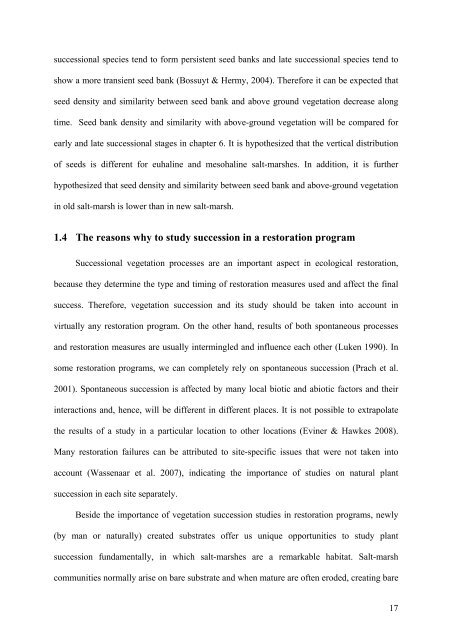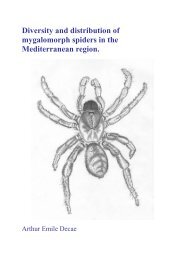PhD Reza Erfanzadeh 2009 - Ghent Ecology - Universiteit Gent
PhD Reza Erfanzadeh 2009 - Ghent Ecology - Universiteit Gent
PhD Reza Erfanzadeh 2009 - Ghent Ecology - Universiteit Gent
Create successful ePaper yourself
Turn your PDF publications into a flip-book with our unique Google optimized e-Paper software.
successional species tend to form persistent seed banks and late successional species tend to<br />
show a more transient seed bank (Bossuyt & Hermy, 2004). Therefore it can be expected that<br />
seed density and similarity between seed bank and above ground vegetation decrease along<br />
time. Seed bank density and similarity with above-ground vegetation will be compared for<br />
early and late successional stages in chapter 6. It is hypothesized that the vertical distribution<br />
of seeds is different for euhaline and mesohaline salt-marshes. In addition, it is further<br />
hypothesized that seed density and similarity between seed bank and above-ground vegetation<br />
in old salt-marsh is lower than in new salt-marsh.<br />
1.4 The reasons why to study succession in a restoration program<br />
Successional vegetation processes are an important aspect in ecological restoration,<br />
because they determine the type and timing of restoration measures used and affect the final<br />
success. Therefore, vegetation succession and its study should be taken into account in<br />
virtually any restoration program. On the other hand, results of both spontaneous processes<br />
and restoration measures are usually intermingled and influence each other (Luken 1990). In<br />
some restoration programs, we can completely rely on spontaneous succession (Prach et al.<br />
2001). Spontaneous succession is affected by many local biotic and abiotic factors and their<br />
interactions and, hence, will be different in different places. It is not possible to extrapolate<br />
the results of a study in a particular location to other locations (Eviner & Hawkes 2008).<br />
Many restoration failures can be attributed to site-specific issues that were not taken into<br />
account (Wassenaar et al. 2007), indicating the importance of studies on natural plant<br />
succession in each site separately.<br />
Beside the importance of vegetation succession studies in restoration programs, newly<br />
(by man or naturally) created substrates offer us unique opportunities to study plant<br />
succession fundamentally, in which salt-marshes are a remarkable habitat. Salt-marsh<br />
communities normally arise on bare substrate and when mature are often eroded, creating bare<br />
17










